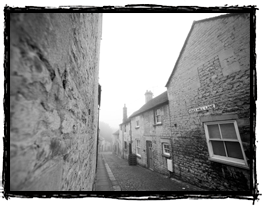The Story of Askers Bakery
In the past, most towns had a bake house on almost every street. In 1835 there were 35 bakeries in Stamford, by 1939 the number had fallen to 17. Askers, with its bake house in King's Mill Lane and shop in Red Lion Street, is now the sole remaining fully independent bakery in Stamford.
Askers still bake in the traditional manner. Their coal-fuelled oven, known as a sack oven, is capable of taking 200 loaves at a time. It is fired up six days a week. There are only extra breaks for bank holidays and for essential maintenance. That's not often. The floor bricks need replacing every five to six years and it takes a week for the oven to cool sufficiently to allow someone to crawl inside. It's still a very hot job.
Loaves are placed in the oven using a 'peel', a flat bladed spatula with a wooden handle that it ten feet long with a blade that can place four loaf tins at a time into the very far corners of the oven.
The oven was overhauled in 1935, re-fronted by 'Kemp & Sons of London' but it probably dates back to the 1800s and, given the bakery's location on King's Mill Lane and 200 yards from the flourmill that worked from the 1640s until WW1, there has probably been a bakery on the site for a very long time.
The records in the Dolby's Almanak show that number 9a on St. Peter's Street, which backs onto the bake house in King's Mill Lane, was a 'Baker & Grocers' from 1906 until 1924. Having a bake house directly behind the shop would make good sense. From after WW1, until the 1950s, 9a is simply recorded as a grocery store.
Augustus Asker came to Stamford from Norfolk in the 1920s. The Askers' family originated in Holland and came to East Anglia sometime in the 1600s to work on the drainage of the Fens. Augustus worked at the Co-operative bakery in Wharf Road, Stamford before he bought the business in King's Mill Lane in 1926/27.
Augustus' grandson, Stuart Asker, now runs the business. He remembers coming down to the bake house on Sundays as a child. "There was always something to do, even if it was just to wash the van." He started working full time in the family business in 1970. Stuart's son Kerry now works at the bake house too, the fourth generation of bakers in Stamford. They're a family who don't get much chance to lie-in in the morning.
"We're up at 5.00 - 5.30am on a normal day, 4.30 - 5.00am on a Friday and Saturday," says Stuart. "But before we got some of the labour saving machines it used to be 2.00am. You definitely need to have a nap in the day." The oven is lit at 6:00am and, depending on the wind direction, will generally get through a bag of coal every day.
Askers bake a variety of breads and confectionary for their shop in Red Lion Street and also supply bread for The George, The Crown, plus pubs and teashops within Stamford and surrounding villages. When Augustus Asker first took on the bakery deliveries were made by bicycle and they got their first van in the 1940s. In 1951 Askers opened their own shop in Broad Street, subsequently moving a short distance into compact premises in Red Lion Street in 1954. They've been there ever since.
It isn't just their oven and their premises that provide a sense of continuity to Askers. The staff are an essential part of the bakery's tradition too. "Anyone that joins the baking trade with us seems to stop." Says Stuart. "Dick Gregory has been with us 18 years. Two people in the last generation, Vic Davies and Lilly Clipsham, worked with us for over 50 years." In the bake house alongside Stuart, Kerry and Dick are two part-time ladies, Katrina Whyte and confectionary specialist Karen Parsons. At the shop five ladies work part-time. "Mrs Walker has been with us 17 years and her daughter works with us now." Not every member of the team plans to stay for so long; every morning the oven is lit by Josiah Kennedy, a sixth form student who is planning to go to university to study philosophy.
The experience of the whole team has helped in the planning and baking for 'A Cake for Every Day'. The majority of the cakes made during the project are not part of Askers' usual repertoire, and Karen Parsons has delved into her mother's cookbooks to find some of the recipes.
In a world dominated by multi national companies and in which our eating habits are dictated by supermarket chains, it's reassuring that at least some small family-run businesses continue to survive, offering the same type of traditional fare that they provided to previous generations and adding tasty new recipes too.
Soraya Smithson - 2009









